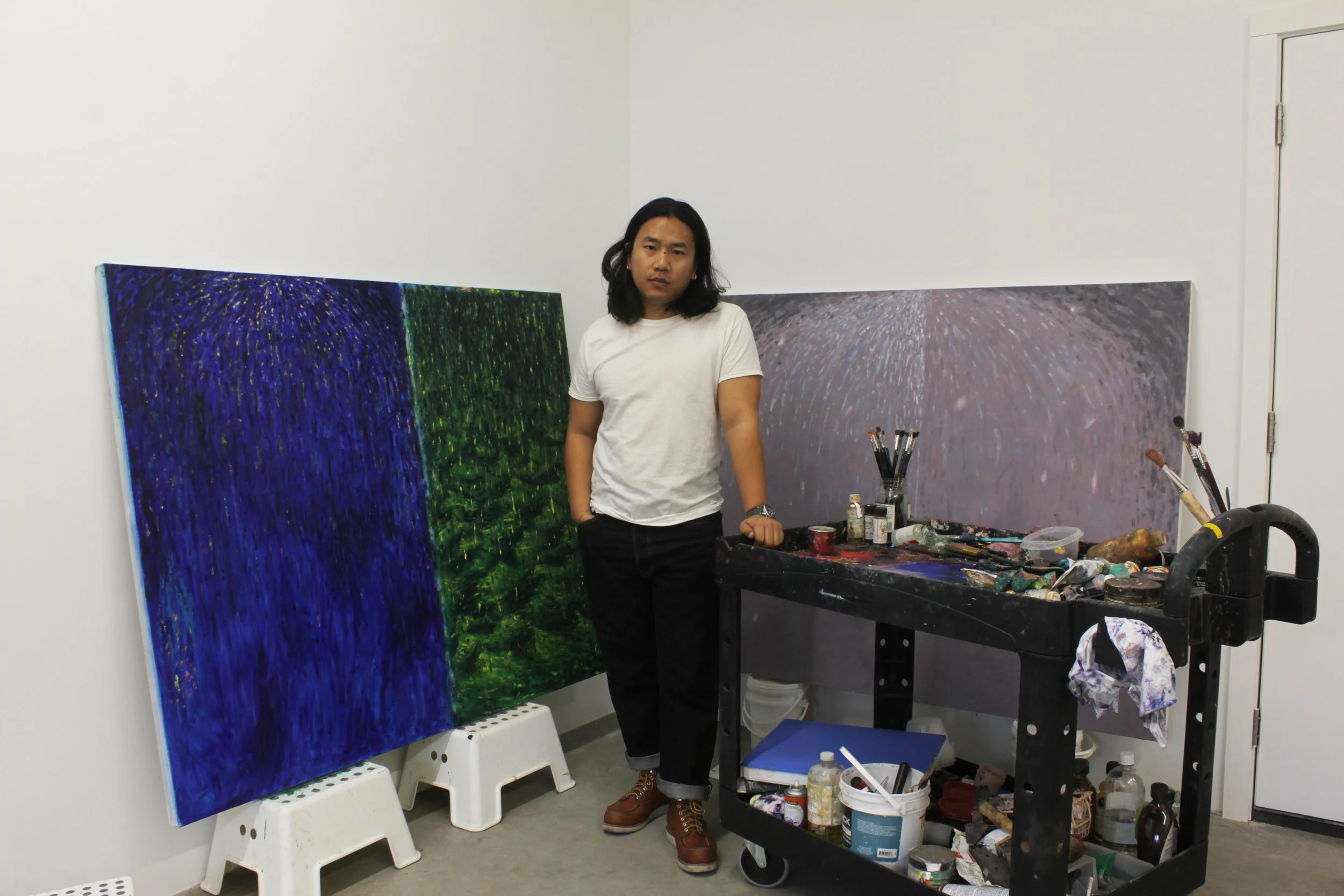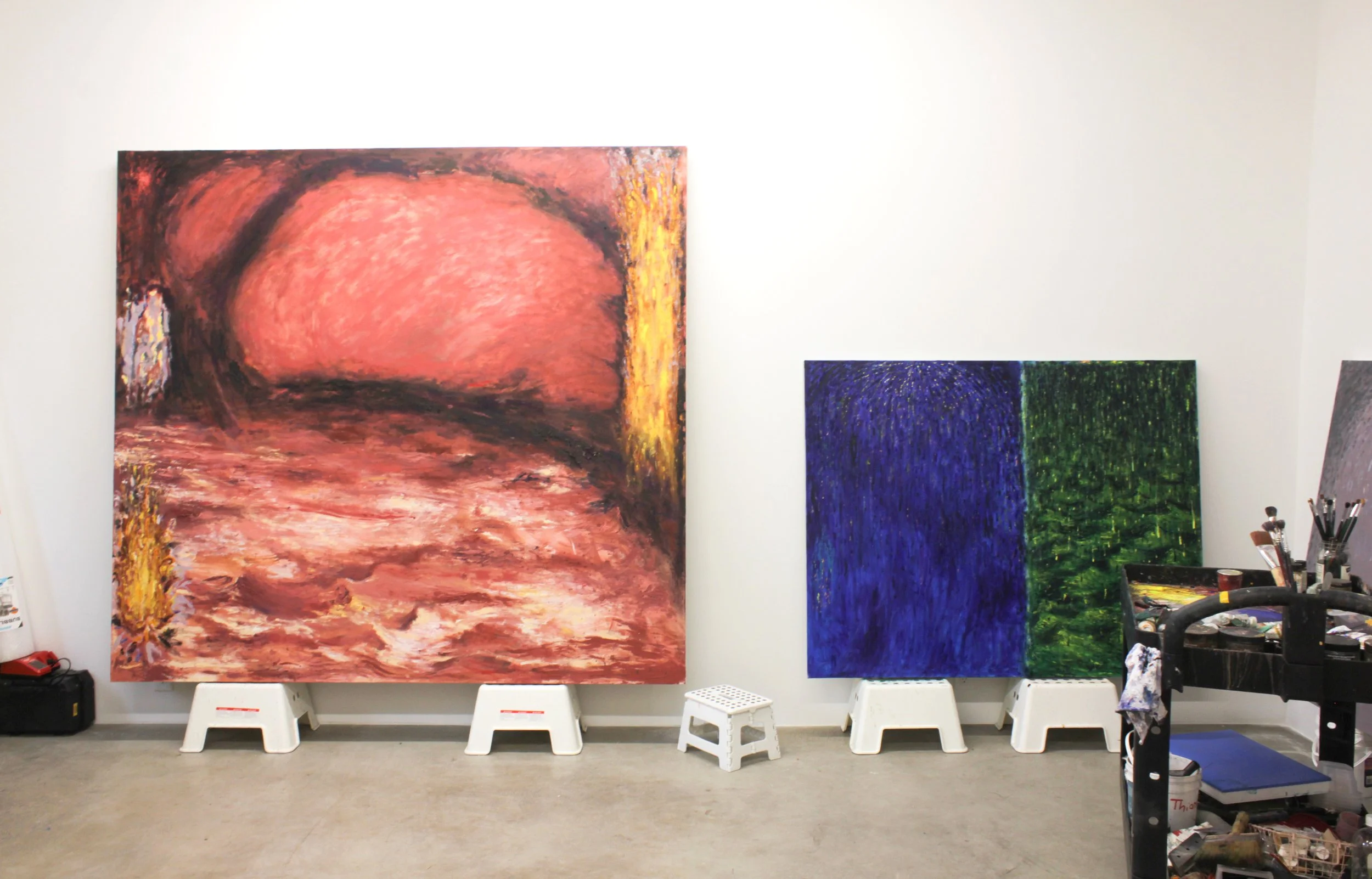Fresh Face: Thiang Uk
Remembering the beauty of Myanmar amidst chaos
A&M's Fresh Face is where we profile an emerging artist from the region every month and speak to them about how they kick-started their career, how they continue to sustain their practice and what drives them as artists.
Thiang Uk in his studio. Image courtesy of the artist.
Thiang Uk’s work is deeply rooted in childhood experiences growing up in Myanmar and the region’s animist myths. Born in Hakha, Myanmar, in 1993, Uk and his family fled the country’s political violence and settled in the United States of America when he was 11 years old. His paintings investigate the complexity of holding multiple identities, ancestral memory, and painterly languages. Thiang received his Master’s in Fine Arts from Maryland Institute College of Art, Baltimore (2021); and attended the Skowhegan School of Painting and Sculpture, Skowhegan, ME (2023). His works have been presented at Bureau (New York City), Sean Kelly LA (Los Angeles), island (New York City), and Museum of Contemporary Art Arlington, amongst others.
Thiang Uk, ShapeShifter Crossing… Searching, 2021, oil on canvas, 182.88 x 182.88cm. Image courtesy of the artist.
The shapeshifter is a key theme in Thiang’s practice. For him, it is a “metaphor for assimilation and adapting to new languages, new cultures, and environments”. Parallel to the artist’s personal history of migration, one can see these distances explored in his paintings. ShapeShifter Crossing… Searching (2021) and other works from that period depict such “between” spaces and the thresholds of different places. Even the figures in his paintings seem to be amorphous, as if in a state of transition.
Thiang Uk, Untitled (Stacked Diptych 1), 2024, oil on panel, 50.80 × 20.32cm. Image courtesy of the artist and Bureau NY.
In Thiang’s first solo exhibition Shadow’s Edge (2025), this bifurcation is explored formally through the doubling of images and the diptych format. The mirroring composition is seen in large paintings such as ‘Ocean in Green (With a Drawing of Franz Marc’s Painting “Horse in a Lanscape”)’ (2024), render the ocean at states of calm and turbulence. Another approach is the joining of two panels to form a diptych. While a narrative or visual connection can be drawn from the two halves such as sky-sea, past-present, peace-turmoil; the format also hints at a third space which cannot be seen and only imagined or felt.
Thiang Uk, Ocean in Green (With a Drawing of Franz Marc’s Painting “Horse in a Landscape”) (detail), 2024, collaged oil pastel drawing on paper on oil on canvas, 184.15 × 214.63cm. Image courtesy of the artist and Bureau NY.
Thiang Uk, Horses, 2024, oil on panel, 20.32 × 25.40cm. Image courtesy of the artist and Bureau NY.
The horse is a recurring motif that carries a range of emotions and subjectivities. In Thiang’s recent paintings, he looks back at art historical precedents such as the 20th century Der Bleue Reiter (The Blue Rider) group, and Gong Kai’s horse paintings from the Song dynasty. In citing these references, Thiang is also interested in the political and spiritual meanings associated with them. The short-lived Blue Rider group broke up at the onset of World War One, while Gong Kai lived through the fall of the Song dynasty. As such, one can interpret these horses as metaphors for human experiences during adversity, reflecting both a desire for freedom and a quiet sense of grief.
Interview
Thiang Uk, Shadow’s Edge, 2025, exhibition view at Bureau, New York City. Image courtesy of the artist and Bureau NY.
You graduated with a Bachelors of Fine Arts at Hunter College, New York City in 2017, and completed your Masters in Fine Arts in Painting at Maryland Institute College of Art (MICA) in Baltimore in 2021. How would you describe your experience/education?
My experience has been mostly positive. Hunter College and New York City shed light on my understanding of contemporary art and surrounded me with faculty and students who prioritised art making. It was truly inspiring.
I went to MICA for their painting-focused programme at The LeRoy E. Hoffberger School of Painting. It was illuminating because the programme went deep in the painting process, its history, and thinking with painting. The only thing was that COVID-19 caused a big interruption and made a dent in my graduation experience.
With that said, I definitely came out of the programme a much better painter.
Zoom crit at MICA during COVID-19 pandemic. Image courtesy of the artist.
Who has been a mentor or an important artistic influence? And why?
I have been lucky to have many mentors or mentor-like figures. Two of them who have made a big impact are probably Stephen Ellis and Joan Waltemath, my professors at MICA. I had a class with Stephen at Hunter College, and then saw him for two more years at MICA. I find the way he taught and how he talked about paintings so effective. He is known for being direct and bringing clarity in his critique. Joan Waltemath's ability to deconstruct paintings for hours and hours was very much needed for my growth.
What was one important piece of advice you were given?
The advice that was constantly given was that I needed to see paintings and art as much as I can, and think with them. The best places to do that are bigger cities.
My analogy is that art cities and art centres can be like bonfires in the cold night for young artists. One needs to sit close for a while to realise if one wants to stay with that particular fire. If the bonfire is too hot, not hot enough, too crowded, then think about how you can start your own fire that would fit your needs.
A finished painting on the left and a work-in-progress in Thiang's studio in Baltimore. Image courtesy of the artist.
Do you make a living completely off being an artist? If not, could you share what other types of work you take on to supplement your income? Do these activities also inform/ affect your practice?
I am currently adjunct teaching, mostly foundational classes at Towson University and MICA. I love the idea of living completely off being an artist, but I would still like to teach a class or two each semester. I will not say teaching affects my painting practice directly, and that it has helped me to be a better communicator in speaking about art. I also like interacting with motivated students; their excitement for art is something that I try to hold onto for myself as well. They are a good reminder of that for me.
What are approaches that have worked in managing your time between this job and your own practice?
It is simple. I schedule my classes on consecutive days during the week when I can, so that I can focus on my studio practice the rest of the week. This has been working well for me.
Thiang Uk, Shadow’s Edge, 2025, exhibition view at Bureau, New York City. Image courtesy of the artist and Bureau NY.
How did the opportunity for your debut solo show ‘Shadow’s Edge’ (2025) at Bureau in New York City come about? Could you talk about the body of work presented as well as one challenge you faced preparing for it?
Gabrielle Giattino, the owner of Bureau, found out about my work through some shared networks, and reached out to express interest. We met up a couple of times after my residency at Skowhegan School of Painting and Sculpture, and that led to an in-person studio visit in Baltimore. The interactions felt very natural and left me feeling great about my work, and Bureau offered a show in their downstairs project space as a place to start working together.
The challenge was balancing work and studio hours while preparing for the show. I was teaching four classes at two different colleges. It was stressful because I wanted to have plenty of options for this show, so I had to do a lot of work and a lot of paintings. I am very happy with how the exhibition turned out.
Thiang Uk, Shadows and Stars, 2024, collaged oil pastel drawing on paper on oil on canvas, 47.5 x 60inches. Image courtesy of the artist and Bureau NY.
The notion of shape-shifting is an important theme in your work. What is its significance to you?
The notion of shape-shifting arises from my grandmother's bedtime stories which are often rooted in Animism and myths. From that root, I use the motif of shape-shifting as a metaphor for assimilation and adapting to new languages, new cultures, and environments as I migrated to new cities, and countries. It is also a way of viewing landscapes and nature as having their own lives and transformation.
“I use the motif of shape-shifting as a metaphor for assimilation and adapting to new languages, new cultures, and environments as I migrated to new cities, and countries.”
How would you describe your relationship with Myanmar?
My family and I migrated to the United States in 2004 due to the political turmoil and economic disparity in Myanmar. I have not had the chance to return because of schooling, jobs, and the lack of funds. The other major issue is of course political instability and the current civil war since 2021. It is not an emotionally clear thing for me to talk about in a short format, but the food, the language, the cultures, the mountains, the street foods… it is always in the back of my mind. I feel it is important to remember the beauty of Myanmar amidst total chaos.
Thiang Uk, The Chase, 2021, oil on canvas, 48 x 64inches. Image courtesy of the artist.
Could you talk about the local art scene in Baltimore?
The Baltimore art scene is small but very giving in my experience. This community feels welcoming and it is easy to meet artists and people working in galleries. We have this phrase “Smalltimore” due to how small it can feel. The city has Baltimore and artists born in the district of Columbia, Maryland and Virginia (DMV) as well as many MICA graduate artists who make interesting works. Baltimore is also fairly affordable compared to other northeastern cities, so it is a great place to live as an artist. Baltimore can be rough, but it has been a fruitful ground for me and many other artists and makers.
Are there any upcoming/ ongoing exhibitions or projects that you would like to share?
I will have my second solo show at Silber Art Gallery at Goucher College located in Towson, Maryland. The show will be curated by Liz Faust and it will run from 10 April to 29 May 2025. We are in the process of putting together that show.
I am also participating in a group show titled Asian North 2025 in Baltimore that will be curated by Phaan Howng. The show will be on view from 2 t0 31 May 2025, and it features many Asian American artists whom I am excited to share the space with.
Thiang Uk’s solo exhibition, Shadow’s Edge is on view at Bureau, New York City, from 1 March to 12 April 2025.











